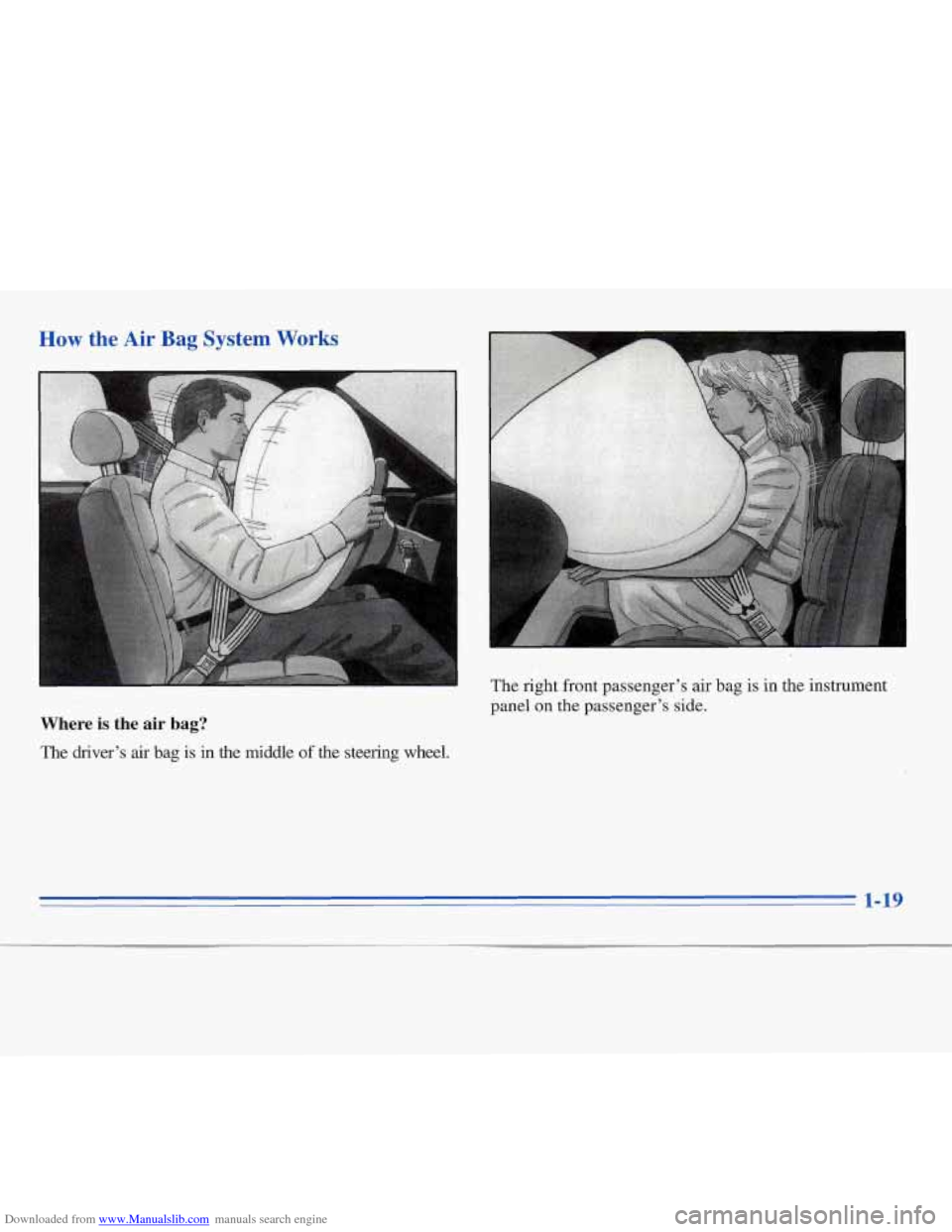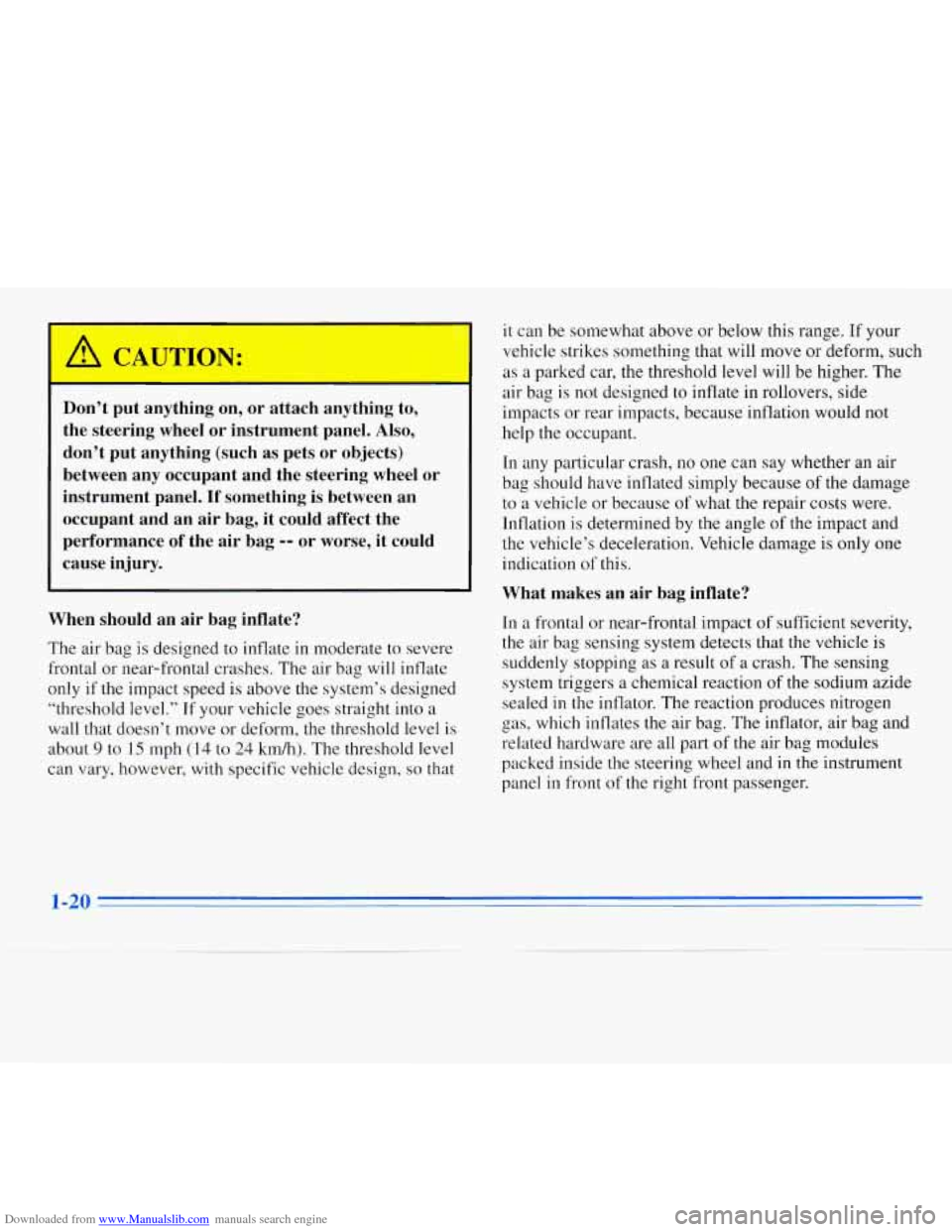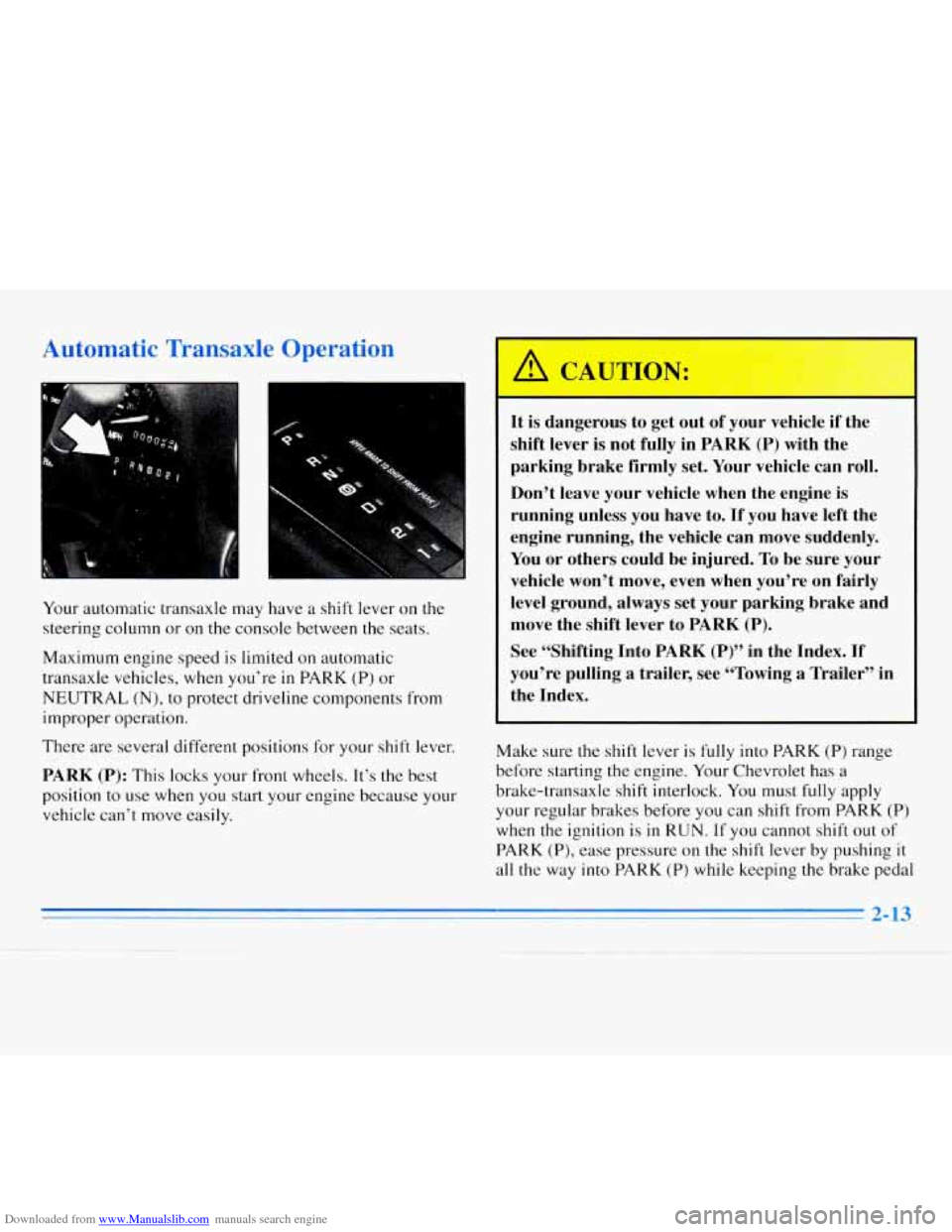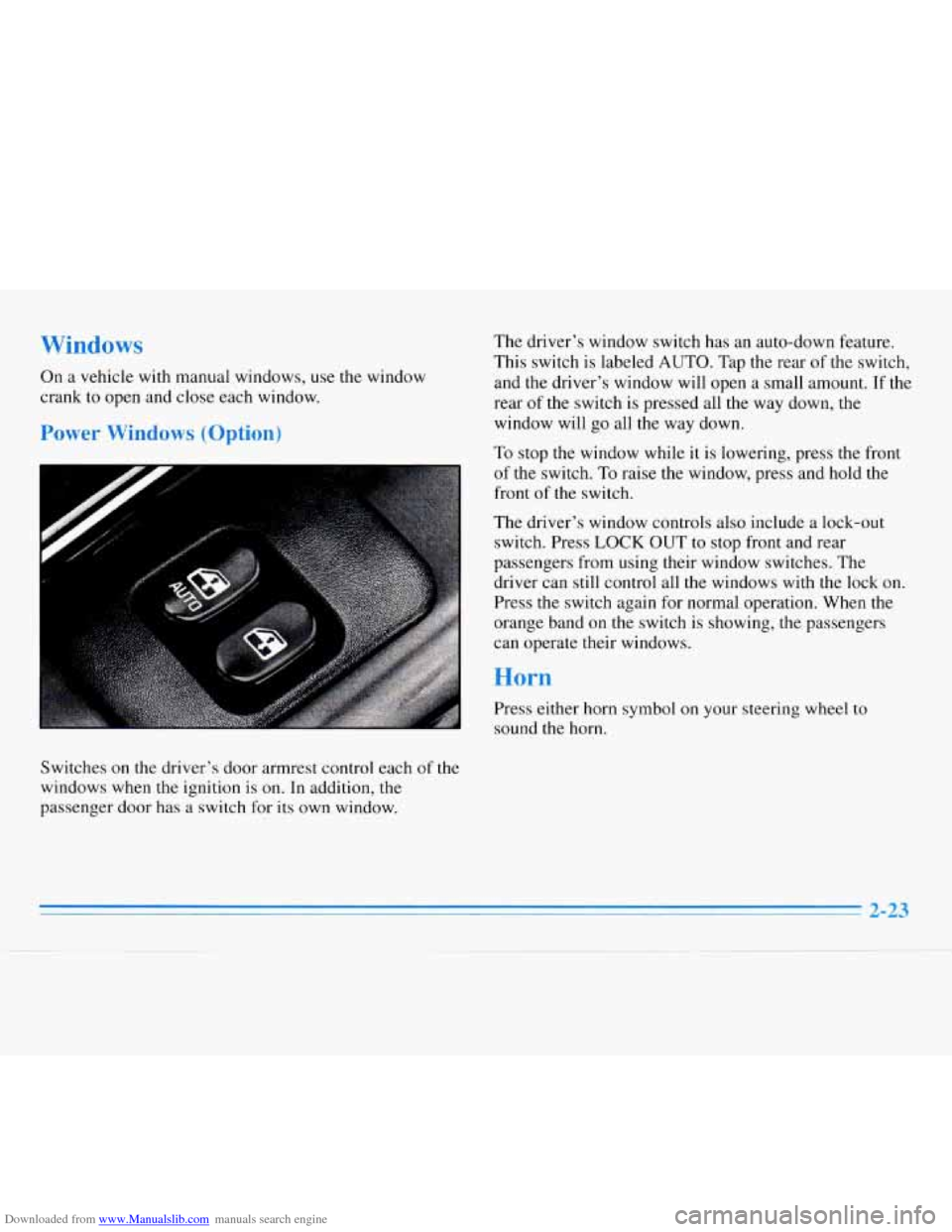1996 CHEVROLET MONTE CARLO steering wheel
[x] Cancel search: steering wheelPage 31 of 340

Downloaded from www.Manualslib.com manuals search engine How the Air Bag System Works
Where is the air bag?
The driver’s air bag is in the middle of the steering wheel. The
right front passenger’s air bag
is in the instrume
panel
on the passenger’s side.
:nt
1-19
Page 32 of 340

Downloaded from www.Manualslib.com manuals search engine Don’t put anything on, or attach anything to,
the steering wheel
or instrument panel. Also,
don’t put anything (such as pets or objects)
between any occupant and the steering wheel or
instrument panel. If something
is between an
occupant and an air bag,
it could affect the
performance of the air bag
-- or worse, it could
cause injury.
When should an air bag inflate?
The air bag is designed to inflate in moderate to severe
frontal or near-frontal crashes.
The air bag will inflate
only
if the impact speed is above the system’s designed
“threshold level.”
If your vehicle goes straight into a
wall that doesn’t move or deform, the threshold level is
about
9 to 15 mph (14 to 24 kmh). The threshold level
can vary, however, with
sneci. vehicle design, so that
it can be somewhat above or below this range. If your
vehicle strikes something that will move or deform, such
as
a parked car, the threshold level will be higher. The
air
bag is not designed to inflate in rollovers, side
impacts or rear impacts, because inflation would
not
help the occupant.
In any particular crash, no one can say whether an air
bag should have inflated simply because of the damage
to
a vehicle or because of what the repair costs were.
Inflation is determined by
the angle of the impact and
the vehicle’s deceleration. Vehicle damage is only one
indication of this.
What makes an air bag inflate?
In a frontal or near-frontal impact of sufficient severity,
the air bag sensing system detects that the vehicle is
suddenly stopping
as a result of a crash. The sensing
system triggers
a chemical reaction of the sodium azide
sealed
in the inflator. The reaction produces nitrogen
gas, which inflates the air bag. The inflator, air bag and
related hardware are all part
of the air bag modules
packed inside the steering wheel and
in the instrument
panel
in front of the right front passenger.
Page 33 of 340

Downloaded from www.Manualslib.com manuals search engine How does an air bag restrain?
In moderate to severe frontal or near-frontal collisions,
even belted occupants can contact the steering wheel or
the instrument panel. The air bag supplements the
protection provided by safety belts.
Air bags distribute
the force of the impact more evenly over the occupant’s
upper body, stopping the occupant more gradually. But
bags would not help you in many types of collisions,
including rollovers, rear impacts and side impacts,
primarily because an 0ccupant:s motion is not toward the
air bag. Air bags should never be regarded as anything
more than a supplement to safety belts, and then only in
moderate to severe frontal
or near-frontal collisions.
What will you see after an air bag ‘inflates?
After the air bag inflates, it quickly deflates. This occurs
so quickly that some people may not even realize the air
bag inflated. Some components of the air bag module in
the steering wheel hub for the driver’s air bag, or the
instrument panel for the right front passenger’s bag, will
be hot for a short time. The part of the bag that comes
into contact with you may be warm, but it will never be
too hot to touch. There will be some smoke and dust
coming from vents in the deflated air bags. Air bag
inflation will not prevent the driver fram seeing or from
being able to steer the vehicle, nor will it stop people
from leaving the vehicle.
I A CAU-ION:
When an air bag inflates, there is dust in the air.
This dust could cause breathing problems for
people with a history of asthma or other
breathing trouble.
To avoid this, everyone in the
vehicle should get out as soon as it is safe to do
so.
If you have breathing problems but can’t get out
of the vehicle after an air bag inflates, then get
fresh air by opening a window or door.
In many crashes severe enough to inflate an air bag,
windshields are broken by vehicle deformation.
Additional windshield breakage may also occur from
the right front passenger’s air bag.
The air bags are designed to inflate only once. After
they inflate, you’ll need some new parts for your air
bag system.
If you don’t get them, the air bag system
won’t be there to help protect you in another crash.
A new system will include air bag modules and
possibly other parts. The service manual for your
vehicle covers the need to replace other parts.
1-21
Page 34 of 340

Downloaded from www.Manualslib.com manuals search engine Your vehicle is equipped with a crash sensing and
diagnostic module, which records information about
the air bag system. The module records information
about
the readiness of the system, when the sensors are
activated and driver’s safety belt usage at deployment.
Let only qualified technicians work on your air bag
system. Improper service can mean that your air bag
system won’t work properly. See your dealer
for service.
NOTICE:
If you damage the cover for the driver’s or the
right front passenger’s air bag, they may not
work properly. You may have to replace the air
bag module in the steering wheel or both the air
bag module and the instrument panel for the
right front passenger’s air bag.
Do not open or
break the air bag covers.
Servicing Your Air Bag-Equipped Chevrolet
Air bags affect how your Chevrolet should be serviced.
There are parts
of the air bag system in several places
around your vehicle.
You don’t want the system to
inflate while someone is working
on your vehicle. Your
Chevrolet dealer and
the Monte Carlo Service Manual
have information about servicing your vehicle and the
air bag system. To purchase a service manual, see
“Service and Owner Publications’’
in the Index.
For up to 10 seconds after the ignition key is
turned off and the battery is disconnected, an
air
bag can still inflate during improper service. You
can be injured if you are close to an air bag when
it inflates. Avoid wires wrapped with
yellow tape
or yellow connectors. They are probably part of
the air bag system. Be sure to follow proper
service procedures, and make sure the person
performing work for you is qualified to do
so.
The air bag system does not need regular maintenance.
1-22
Page 65 of 340

Downloaded from www.Manualslib.com manuals search engine Remote Trunk Release (Option)
Press the button under
the instrument panel
on
the driver’s side. Your
transaxle shift lever must
be in PARK
(P).
Remember that your trunk can be opened at any time
using this lock release. Be sure to lock your doors.
Theft
Vehicle theft is big business, especially in some cities.
Although your Chevrolet has a number
of theft-deterrent
features, we know that nothing we put on it can make
it
impossible to steal. However, there are ways you can help.
Key in the Ignition
If you leave your vehicle with the keys inside, it’s an
easy target for joy riders or professional thieves
-- so
don’t do it. When
you park your Chevrolet and open the driver’s door,
you’ll hear
a chime reminding you to remove your key
from the ignition and take it with you. Always do this.
Your steering wheel will be locked, and
so will your
ignition and transaxle. And remember to lock the doors.
Parking at Night
Park in a lighted spot, close all windows and lock your
vehicle. Remember
to keep your valuables out of sight.
Put them in a storage area, or take them with you.
Parking Lots
Tf you park in a lot where someone will be watching
your vehicle, it’s best
to lock it up and take your keys.
But what if
you have to leave your ignition key? What if
you have to leave something valuable in your vehicle?
0 Put your valuables in a storage area, like your trunk
Lock the glove box.
or glove box.
0 Lock all the doors except the driver’s.
0 Then take the door key with you.
Page 68 of 340

Downloaded from www.Manualslib.com manuals search engine Ignition Switch
C
With the ignition key in the ignition switch, you can turn
the switch to
five positions:
ACC (A): This position lets you use things like the
radio and windshield wipers when the engine is off. To
use ACC (Accessory), push in the key and turn it toward
you. Your steering wheel will stay locked.
LOCK-(B): Before you put the key into the ignition
switch, the switch is in LOCK. It’s also the only position
in which you can remove your key. This position locks your
ignition, steering wheel and transaxle. It’s a
theft-deterrent feature.
OF” (C): This position lets you turn off the engine but
still turn the steering .wheel. It doesn’t lock the steering
wheel like LOCK. Use
OFF if you must have your
vehicle pushed
or towed.
RUN (D): This position is where the key returns after you
start your vehicle. With the engine off, you can use RUN
to display some of your warning and indicator lights.
START (E): This position starts your engine.
A warning chime will sound if you open the driver’s
door when the ignition is in
OFF, LOCK or ACC and
the key is in the ignition.
NOTICE:
If your key seems stuck in LOCK and you can’t
turn
it, be sure it is all the way in. If it is, then
turn the steering wheel left and right while you
turn the key hard. But turn the key only with
your hand. Using
a tool to force it could break
the key or the ignition switch. If none
of this
works, then your vehicle needs service.
2-10
Page 71 of 340

Downloaded from www.Manualslib.com manuals search engine Automatic Transaxle Operation
-I
Your automatic transaxle may have a shift lever on the
steering column or on the console between the seats.
Maximum engine speed
is limited on automatic
transaxle vehicles, when you’re
in PARK (P) or
NEUTRAL (N), to protect driveline components from
improper operation.
There are several different positions for your shift lever.
PARK (P): This locks your front wheels. It’s the best
position to use when
you start your engine because your
vehicle can’t move easily.
It is dangerous to get out of your vehicle if the
shift lever
is not fully in PARK (P) with the
parking brake firmly set. Your vehicle can
roll.
Don’t leave your vehicle when the engine is
running unless you have to.
‘If you have left the
engine running, the vehicle can move suddenly.
You
or others could be injured. To be sure your
vehicle won’t move, even when you’re on fairly
level ground, always set your parking brake and
move the shift lever to
PARK (P).
See (‘Shifting Into PARK (P)” in the Index. If
you’re pulling a trailer, see “Towing a Trailer” in
the Index.
Make sure the shift lever is fully into PARK (P) range
before starting the engine. Your Chevrolet has
a
brake-transaxle shift interlock. You must fully apply
your regular brakes before you can shift from PARK (P)
when the ignition is
in RUN. If you cannot shift out of
PARK (P), ease pressure on the shift lever by pushing it
all the way into PARK (P) while keeping the brake pedal
- 2-13
Page 81 of 340

Downloaded from www.Manualslib.com manuals search engine On a vehicle with manual windows, use the window
crank
to open and close each window.
Switches
on the driver’s door armrest control each of the
windows when the ignition is on. In addition,
the
passenger door has a switch for its own window. The
driver’s window switch has an auto-down feature.
This switch
is labeled AUTO. Tap the rear of the switch,
and the driver’s window will open a small amount. If the
rear of the switch
is pressed all the way down, the
window will go all the way down.
To stop the window while it is lowering, press the front
of the switch. To raise the window, press and hold the
front of the switch.
The driver’s window controls also include a lock-out
switch. Press
LOCK OUT to stop front and rear
passengers from using their window switches. The
driver can still control all
the windows with the lock on.
Press the switch again for normal operation. When the
orange band on
the switch is showing, the passengers
can operate their windows.
’Torn
Press either horn symbol on your steering wheel to
sound the horn.